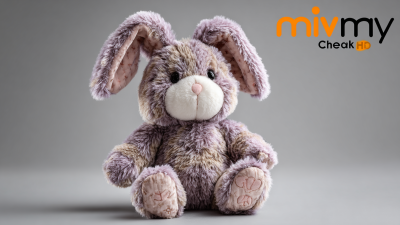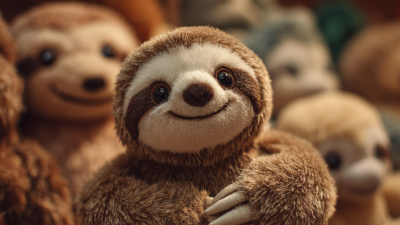As the 138th Canton Fair unfolds in 2025, the spotlight casts a warm glow on the evolving trends within the plush toy market, particularly focusing on the beloved Bunny Soft Toy. According to a recent market analysis by Grand View Research, the global plush toy market is projected to reach approximately $10 billion by 2026, with a significant share attributed to innovative and eco-friendly designs that cater to diverse consumer preferences. The allure of Bunny Soft Toys has notably surged, with a 15% growth rate over the past year, driven by increasing demand from both international and domestic markets. This significant trend aligns with evolving consumer interests in safe, sustainable, and engaging toys that not only provide comfort but also enhance imaginative play. The Canton Fair serves as a vital platform for manufacturers and retailers to showcase their latest Bunny Soft Toy creations, tapping into emerging consumer trends and preferences that resonate with environmentally-conscious parents and gift-givers alike.

At the 138th Canton Fair in 2025, the spotlight shone brightly on innovative designs of bunny soft toys, reflecting the industry's commitment to creativity and sustainable practices. Recent market reports from the Toy Association indicate that the global plush toy market reached approximately $21 billion in 2022, with a projected growth rate of 4.5% annually. This trend highlights the increasing consumer demand for unique and eco-friendly toys, pushing manufacturers to rethink their design strategies.

Emerging designers at the fair showcased an array of bunny soft toys that feature eco-conscious materials, like organic cotton and recycled plastics, aligning with consumer preferences for sustainability. According to a report by Statista, 70% of parents are now more likely to purchase toys made from environmentally friendly materials. The creative designs at the fair, including customizable features and multifunctional aspects, indicate a shift towards personalization in the toy industry. As consumers increasingly seek products that resonate with their values, bunny soft toys at the Canton Fair have embraced innovation as a key pillar to capture market interest and address contemporary concerns.
At the 138th Canton Fair in 2025, the spotlight on bunny soft toys revealed a remarkable shift towards sustainable materials in production. Recent industry reports indicate that the global market for eco-friendly toys is projected to grow at a CAGR of 11.2% from 2025 to 2030. This increasing consumer demand for sustainable products is encouraging manufacturers to explore biodegradable fabrics and non-toxic dyes, ensuring that soft toys are not only safe for children but also gentle on the environment.
Bunny soft toy producers are now focusing on sourcing materials such as organic cotton, recycled polyester, and natural rubber. A study published by the Toy Association highlights that 63% of parents prefer buying toys made from sustainable materials, reflecting a significant trend that companies must consider in their sourcing strategies. Manufacturers who adopt these practices not only meet market demands but also build brand loyalty among eco-conscious consumers.
**Tips for Selecting Sustainable Bunny Soft Toys:**
1. Look for certifications like OEKO-TEX® or GOTS to ensure materials are organic and free from harmful substances.
2. Choose brands that provide transparency about their sourcing practices and production processes.
3. Consider the durability of the toy; long-lasting products reduce waste and are a more sustainable option in the long run.
| Material Type | Popularity (%) | Eco-friendliness Rating (1-5) | Average Price ($) |
|---|---|---|---|
| Organic Cotton | 35 | 5 | 25.00 |
| Recycled Polyester | 28 | 4 | 22.50 |
| Bamboo Fiber | 25 | 5 | 30.00 |
| Tencel | 10 | 5 | 35.00 |
| Hemp | 2 | 4 | 40.00 |
At the 138th Canton Fair in 2025, the showcased bunny soft toys reveal a compelling interplay between design and cultural influences. Various exhibitors have demonstrated how traditional motifs have been reinterpreted in contemporary designs, reflecting a blend of heritage and modern aesthetics. For instance, the incorporation of vibrant colors and playful patterns often mirrors regional festivities and celebrations, emphasizing the significance of cultural narratives in the crafting of these toys.
Moreover, the fair highlights the rising global interest in eco-friendly materials, driven by a cultural shift towards sustainability. Many brands are now adopting biodegradable fabrics and organic stuffing, appealing to environmentally conscious consumers. This trend not only addresses environmental concerns but also resonates profoundly with cultural values that prioritize harmony with nature. As buyers increasingly seek toys that offer both enjoyment and ethical reassurance, the influence of cultural attitudes on product development becomes increasingly evident, demonstrating how bunny soft toys are not merely playthings but also carriers of deeper societal messages.
This chart illustrates the trend of bunny soft toys based on various cultural influences observed at the 138th Canton Fair in 2025. The popularity score reflects consumer interest in different categories such as eco-friendliness, educational value, classic designs, customization options, and interactivity.
The 138th Canton Fair in 2025 showcased a vibrant variety of
bunny soft toys, reflecting the shifting dynamics of consumer preferences. Attendees were particularly
interested in eco-friendly materials, showcasing a trend towards
sustainability in the toy industry. Parents and collectors alike expressed a growing concern for the
environmental impact of production processes, leading to a heightened demand for plush toys crafted
from organic fabrics and biodegradable materials. This shift indicates a
broader awareness among consumers about the importance of sustainability, influencing purchasing
decisions significantly.
In addition to eco-friendliness, customization emerged as a key
trend at the fair. Many consumers are seeking bunny soft toys that reflect personal touches, such as
colors, patterns, or even the option to add names. This desire for individuality is revolutionizing the
traditional toy market, as manufacturers explore innovative ways to offer personalized products. The
integration of technology, such as augmented reality features or
interactive elements, also captured the attention of visitors, demonstrating that the
modern bunny soft toy must not only be adorable but also engage the user in new and exciting ways.
The 138th Canton Fair in 2025 presents a unique platform for bunny soft toy manufacturers to forge meaningful connections and explore new business opportunities. With the growing popularity of bunny-themed products among consumers, this event becomes a pivotal gathering for industry players. Manufacturers can engage in networking activities that foster collaboration, enabling them to share insights about the latest trends, consumer preferences, and innovative designs in the plush toy market.
The fair's dynamic environment accelerates the exchange of ideas, allowing manufacturers to establish vital relationships with suppliers, distributors, and retailers. Workshops and panel discussions on market trends and consumer behavior will further equip participants with valuable knowledge tailored to the bunny soft toy niche. By leveraging these networking opportunities, manufacturers can not only enhance their product offerings but also adapt to shifting market demands, ensuring they remain competitive in an ever-evolving industry. As excitement builds for the event, stakeholders are eager to connect, innovate, and thrive in the bunny soft toy market.







